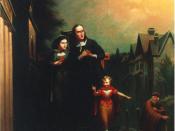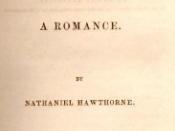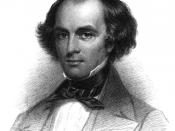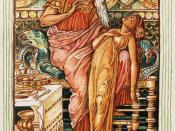Nathaniel Hawthorne's classic novel The Scarlet Letter revolves around the story of Hester Prynne, a woman who commits the sin of adultery. Set in an early New England colony, the book shows the terrible impact that Hester's single, passionate act has on the lives of the main characters of the community. The emotions and feelings that surround the impact are directed by Hawthorne through the use of a multitude of themes. Colors, with an emphasis upon light and darkness, is a persistent theme of contrasting ideas throughout the novel. These colors are not just used for scenic description, but also to give the reader a better understanding of the characters. Although traditionally authors use light and darkness to signify good and evil, in The Scarlet Letter, Hawthorne breaks tradition by giving light and darkness new and deeper meanings in which light conveys truth and innocence while darkness symbolizes guilt and deceit, as personified by Dimmesdale, Pearl and Hester.
Mister Dimmesdale is the dark, untruthful character in the novel. He lives a life of guilt and dishonesty, and is aware of this, yet he is not able to confess and change this fact. It is his fear that his public image will be damaged that leads him to a life of fraudulence. Dimmesdale is aware of his hypocritical action and tries to repent by confessing on the scaffold, but uses the shadow of night to protect himself. While standing between Hester and Pearl on the scaffold and feeling energy rush through him, Pearl innocently asks the minister, "Wilt thou stand here with mother and me, to-morrow noontide?". Dimmesdale replies that he will not, for fear that the townspeople might see him. Dimmesdale commits himself to Hester by engaging in a relationship with her, yet never publicly acknowledges his commitment to her. In the forest, darkness temporarily leaves Dimmesdale as he opens up to Hester and they plan their escape to Europe. Though it seems all is well and Dimmesdale is finally revealing his true emotions, Hawthorne describes the sky as a "clouded sky and the heavy foliage had darkened the noontide". In the forest, nature acts as God, and by casting a shadow of darkness it rejects Dimmesdale's words. Nature can see through the obvious, and like God, knows that Dimmesdale is expressing his feelings in vain. Hawthorne uses darkness and shadows to signify how Dimmesdale's actions are deceitful and cowardice, because even though the reverend knows of his true responsibilities towards Hester and Pearl, he refuses to recognize these obligations publicly.
Hawthorne also uses black and darkness as symbols throughout The Scarlet Letter. Black is used to represent evil and hiding. Hawthorne calls the prison the "black flower of civilized society," meaning it is evil and a place concealing the truth. Pearl's eyes are called a "small black mirror," meaning they are empty and filled with sin as they reflect Hestor's scarlet letter. Hawthorne explains black weeds growing from a sinner's grave as evil coming out and dying hope. The Puritan's describe Satan as the Black Man in the forest. Black is used to symbolize the worst and most evil part of an object or person. Frequently Hawthorne makes references to darkness turning to light, suggesting darkness as a state of hiding where the person will not accept life's experiences and holds back.
Hawthorne employs white and light to oppose darkness as a state of self- containment. White most clearly symbolizes purity. Ironically, Dimmesdale's offspring is the opposite of her father and is the light of the novel. Pearl is the only pure and truthful character in the novel and is the light of the dark and deceptive Puritan world. Early in the book Pearl has an affinity with sunlight. While in governor Bellingham's mansion, Pearl inquires about playing with the sunlight. Hester responds, "Thou must gather thine own sunshine. I have none to give thee!", admitting that she is living a guilty and dishonest life. Like light, Pearl sparkles and glitters but her radiance never fades. Pearl is aware that she emits brightness and innocence and insists that she was plucked off the rosebush outside the prison. Pearl's self-reference to the rosebush, which Hawthorne describes as a "sweet moral blossom" reinforces her theory that she is the light in a dark world. Due to her young age, Pearl does not understand or care what the public thinks of her. As a result of this purity, Pearl is blunt and completely honest with her feelings. Light, similarly as darkness, can act as God, by having the power to reveal a person's true identity. When a dishonest person is in the light, he/she cannot hide from his/her wrongdoings and as a result the person avoids light. Pearl does not fear the truth, because she knows that she is true to herself. She is also aware that by standing in the light, nothing new about her character will be revealed, because she is open and truthful to the public as well as herself. Not only is Pearl aware of society's judgmental views toward herself, and Minister Dimmesdale, but she also understands its intolerant analysis of her mother. Pearl, who has not committed any great sins nor held herself back from anything, is always portrayed with the light shining on her.
Hester, unlike her daughter, is a perplexed character, who is stuck between the light and darkness. Initially Hester is a prisoner of darkness because of her passionate sin. Her honest and caring actions, helping the poor and sick, alleviate her guilt, but do not clear her name. When Hester removes her scarlet letter and faces her sin and pride, the sunlight shines on her for the first time. The sunshine is used to express a moment of enlightenment and change Remember that the sunlight never falls on Hester until she lets down her hair and casts away the scarlet letter. This is Hawthorne's way of saying that nature, like God, is often more forgiving than man is. As long as Hester feels sinful, nature shuns her but when she mentally steps into the light, nature gives her the light to step into physically, making her seem even more lovely. Through her actions in the novel, Hester emerges from a state of darkness to a higher level of lightness, resembling her radiant daughter.
Hawthorne uses light and darkness to express character's emotions and the state of their spirit. Darkness represents a poor state with self-denial, as well as representing simply evil. Light symbolizes a state of enlightenment and a refreshed spirit, as well as purity. The color symbols in The Scarlet Letter help to transfer certain themes and ideas to the reader, as they are easily recognized and identified. Hawthorne's novel shows the simplest events of one person permeating throughout a society, and how the primitive ideas of symbolism of light and dark can parallel this passage.






